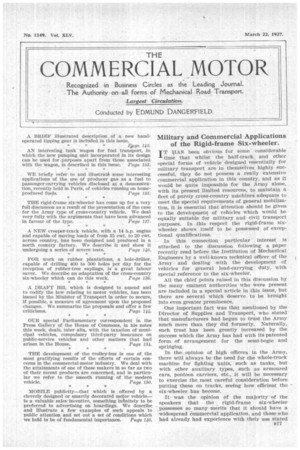Military and Commercial Applications of the Rigid-frame Six-wheeler.
Page 43

Page 44

If you've noticed an error in this article please click here to report it so we can fix it.
IHAS been obvious for some considerable "atime that whilst the half-track and other special forms of vehicle designed essentially for military transport are in themselves highly successful, they do not possess a really extensive commercial application in this country, and as it would be quite impossible for the Army alone, with its present limited resources, to maintain a fleet of purely cross-country machines adequate to meet the special requirements of general mobilization, it is essential that attention should be given to the development of vehicles which would be eqUally suitable for military and civil transport purposes. In this respect the rigid-frame sixwheeler shows itself to be possessed of exceptional qualifications.
-In this connection particular interest Is attached to the discussion following a paper recently read before the Institution of Mechanical Engineers by a well-known technical officer of the Army and dealing with the development of vehicles for general load-carrying duty, with special reference to the six-wheeler.
All the chief points raised in this discussion by the many eminent authorities who were present are included in a special article in this issue, but there are several which deserve to be brought Into even greater prominence.
One important fact was that mentioned by the Director of Supplies and Transport, who stated that manufacturers had begun to trust the Army much more than they did formerly. Naturally, such trust has been greatly increased by the success which the Army has had with its patented form of arrangement for the semi-bogie and springing.
In the opinion of high officers in the Army, there will always be the need for the whole-truck machine for fighting units, such as tanks, but with other auxiliary types, such as armoured cars, pontoon carriers, etc., it will be necessary to exercise the most careful consideration before putting these on tracks, seeing how efficient the six-wheeler has become.
It was the opinion of the majority of the speakers that the rigid-frame six-wheeler possesses so many merits that it should have a widespread commercial application, and these who had already had experience with their use stated that the promises made at the time of purchase had been fully borne out. As regards overseas application of rigid-frame six-wheelers, it is of the utmost importance that British makers should clear away all downhanging parts, such as brake levers, which are so often disposed in what may be termed the danger zone, or that which would be entered by hummocks or other projections from the genund when traversing rough country. It is of little use designing for overseas use types of vehicle which may quickly be damaged and stalled through the neglect of comparatively minor items. Other factors of vital importance in the sixwheeler are that it can climb a gradient 100 per cent. greater than a four-wheeler, whilst the same increase applies to drawbar pull.
London's Terrible Toll of Life in Traffic.
THE report on streets accidents in Greater London contains some very disturbing figures. From the year 1921 onwards the total number of fatal accidents in Greater London has gradually increased until, in the year 126, it reached the figure of 1,020, almost three persons a day every day of the week. The number killed in the City of London, where, of course, streets are narrower and congestion greater, remains practically constant, the average for the number killed last year, 17, not exceeding the average for the past seven years. The number of persons injured during the year has risen from 21,000 in 1920 to 47,213 in 1926, a figure that really must be got down in some way. It is not easy to draw conclusions from the age of the persons killed and injured, but it does seem as if children are reaping the advantage of better Instruction at school in crossing the roads, because, whilst the number of Children killed has increased. the percentage of children in the total shows a steady diminution, as it has fallen from 26.39 to 20.70. Of the persons killed in the Metropolitan Police District, 703 were pedestrians, 139 cyclists, 77 motorcyclists, 83 occupants of vehicles and one a horse rider. • Private motor vehicles still lead the list in the classification designed to show the number of accidents associated • with each class of vehicle. We will take for our comparison the years 1920 and 1926. Accidents in which they were concerned numbered 13,303, as compared with 4,030 in the earlier year; accidents in which motor omnibuses 'were concerned increased from 1,582 to 3,390, whilst trade and commercial motor vehicles were concerned, in 1920, with 2,552 accidents and with 6,107 in 1926, so that the growth in the use of motorcars is well reflected in the increase in the number of accidents. Next to the private motorcar, the pedal cycle is responsible for the largest number of accidents, viz., 8,695, the exceptionally large number of which is easily understandable when one considers the lack of responsibility generally shown by the average cyclist.
A First Real Attempt to Reduce Traffic Dangers.
THE growth in the number of street accidents in London has caused considerable concern to the Minister of Transport, and he has taken the wise step of calling a conference of a number of local authorities and other interested bodies, which took place in London yesterday (Monday). This conference discussed the report of the London and Home Counties Traffic Advisory Committee and also considered the draft Road Traffic Bill (referred to elsewhere) in so far as it bears on the prevention of accidents. A number of suggestions was put forward for B18 discussion. One of the most useful was that a street safety committee should be appointed by each Metropolitan borough council to consider and make recommendations as to the steps to be taken in their respective 'boroughs, on the erection of street refuges and on other questions that would help to minimize the risks to road users. The London County Council placed on the agenda for discussion the emission of smoke and grit, etc., from steam vehicles in its relation to street accidents. The education of cyclists against careless cycling and of all classes of road user as to proper road use was very strongly advocated from two quarters. Physical fitness of drivers., the provision of alternative routes to main thoroughfares, the better lighting of vehicles and the use of rear reflectors, or preferably rear lights, on bicycles, the use of autorriatic stop-signalling devices ontrams, the employment of more police officials on traffic-control duty, the introduction of a unified system and the greater enforcement of the use of white lines, the compelling of drivers to keep as close as possible to the left-hand side of the roadway, compulsory insurance against third-party risks, the prohibition of cab loitering, the general adoption of better rules for pedestrian traffic, the railing off of the pavements at certain places in busy thoroughfares, the prohibition of cutting-in at tramway stopping places, the retention of a maximum speed limit, the prevention of overtaking at recognized crossings, the use of rear-view mirrors, the placing of the driver always at the right-hand side of the vehicle, the abolition of horse-drawn traffic or confinement to quieter streets, the compulsory use of four-wheel brakes, the question of route service numbers on the sides of public-service vehicles as well as on the ends— all these and many important matters are down for discussion, and it certainly seems to us that here, for the first time, is a serious attempt to put a stop to what is a growing menace to the welfare of the inhabitants of the Metropolis.
The Trolley-bus an Example in Travel Refinement.
mTHEN, in 1919, it became clear that the tramway systems of the country, in all cases but those which were exceptionally situated, were doomed to early demise, we advocated the appropriation by the commercial motor makers of the design and manufacture of the trolley-bus, which could have been allowed to fall into the hands of the tramcar works. We are glad that our advice was adopted, for, to-clay, when this., section of the industry is sufficiently substantial to be worth consideration, a type of vehicle is being produced which does enormous credit to designers and makers alike. It is true to say that the trolleybus is one of the most pleasant public-service vehicles to ride in. It is almost silent in operation and thus involves a minimum of nerve strain to passengers and passers-by, it is speedy and alert, smooth in running, easy in starting and accelerating and can be brought to a standstill with little or no jerking. It is free from the objection to the tramcar in any narrow street of a town in that it is not prone to ,cause obstruction. It can be manceuvredas freely as an independent vehicle and it can overtake, or be overtaken by, vehicles engaged on the same service, and it picks up' its passengers and sets them down at the kerb. Except that it is tied to its overhead wires, it is an ideal public service vehicle. It must have an overhead equipment, but this is capable of much readier extension than a tramway track would be, and the use of the trolley-bus enables a tramways committee to break away from the tramway and yet to continue to provide a load for the municipal power station off the peak hour for lighting.




















































































































